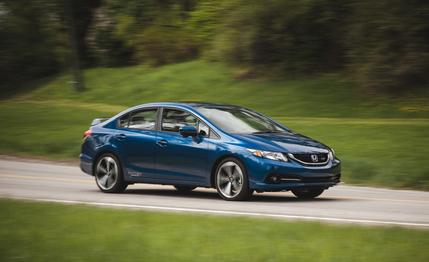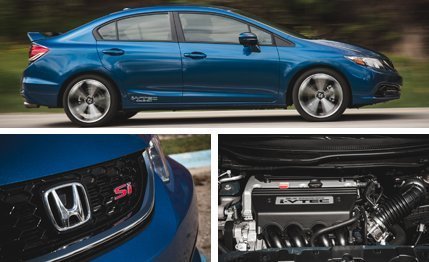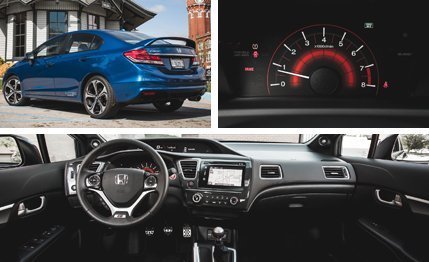 Instrumented Test
Instrumented Test
The final breaths of the naturally aspirated Civic Si should arrive at the top end of a glorious 7000-rpm tear. Instead, the 2014 Honda Civic Si is sucking wind as it’s left behind in the sport-compact segment. Although it remains true to the 29-year-old formula of cheap, light, and high-revving entertainment, the updated 2014 Civic Si is compromised by a chassis that refuses to play along. Metaphorically speaking, we’re still waiting for this Civic Si’s VTEC to kick in.
By and large, cheap front-wheel-drive thrills now come with turbochargers and the fat torque curves they bestow, and we’d bet money that one of Honda’s upcoming boosted engines will find its way into the next-generation Civic Si. Until then, the hotted-up Civic gets by with only incremental gains, such as the additional four horsepower and four lb-ft of torque afforded by a new exhaust system. Now making 205 horsepower and 174 lb-ft, the 2.4-liter four-cylinder pulled the Si to a slower-than-expected 6.5-second 0-to-60 time and a 15.1-second quarter-mile. We’ve seen a 2012 Honda Civic Si sedan do these deeds in as little as 6.1 seconds and 14.7 seconds and believe the 2014 is capable of quicker times. We were slowed slightly by a crunchy gearbox that refused to be rushed during the shift from first to second.

The Almighty—and Endangered—Limited-Slip Differential
The Civic Si rides on wheels one inch larger than those of last year’s car, at 18 inches, as well as tires 10 millimeters wider. We measured lateral grip at 0.87 g around the skidpad and found that the car performed at an even higher level on dampened twisty roads, where the Continental all-season rubber gripped so doggedly that we didn’t even miss the optional summer tires. Thanks to the limited-slip differential—and the dearth of torque—the Si blitzed out of corners at full throttle with barely a hint of wheel spin.
You can pair summer tires and navigation in the Civic Si coupe, but four-door buyers must choose one or the other or neither. All Civic Si models now ship with Honda’s new Display Audio head unit, a pancake-flat rectangle without a single knob and only two physical buttons. Although that sounds like the perfect recipe for something we’d hate, the good news is that the on-screen icons are large and the navigation map responds to pinches, swipes, and double-taps as you expect it to—just like your smartphone. It’s as if Honda’s engineers were the first in the automotive industry to use an iPhone before designing a touch-intensive system. And a side bonus is that many audio features can be manipulated via redundant thumb controls on the steering wheel.

Light, but Not Nimble
The Civic Si goes down the road with a feeling of lightness, because at 2996 pounds, it is measurably lighter than the 3100-to-3200-pound hatchbacks that now rule the sport-compact scene. Yet Honda failed to capitalize on that advantage. Mediocre chassis tuning squanders the baked-in agility that comes with low mass. Despite firmer springs, a stiffened rear anti-roll bar, and retuned dampers for 2014, the Si still wallows and bucks when the road introduces big changes in pitch and roll. The slow steering, at 2.8 turns lock-to-lock, suffers from vague on-center feel and an unsettling lightness in corners. After a loop of our lumpy, sinuous 10Best route, we came away more impressed with the ride quality than the handling. In a Civic Si, that’s just wrong.
Honda’s Si formula has a special place in our hearts, but as smooth and zingy as it might be, the naturally aspirated engine puts the Civic on the wrong side of progress and the chassis dynamics rank just above those of an economy car. Competitors such as the Volkswagen GTI and Ford Focus ST offer a more engaging experience and higher limits, and then there is the overall goodness of rear-wheel-drive ringers like the Subaru BRZ and Scion FR-S. The next-generation Civic Si likely will stray from its roots with turbocharging, but if that’s what it takes to return the model to greatness, then that’s change we can get behind.